Doubt
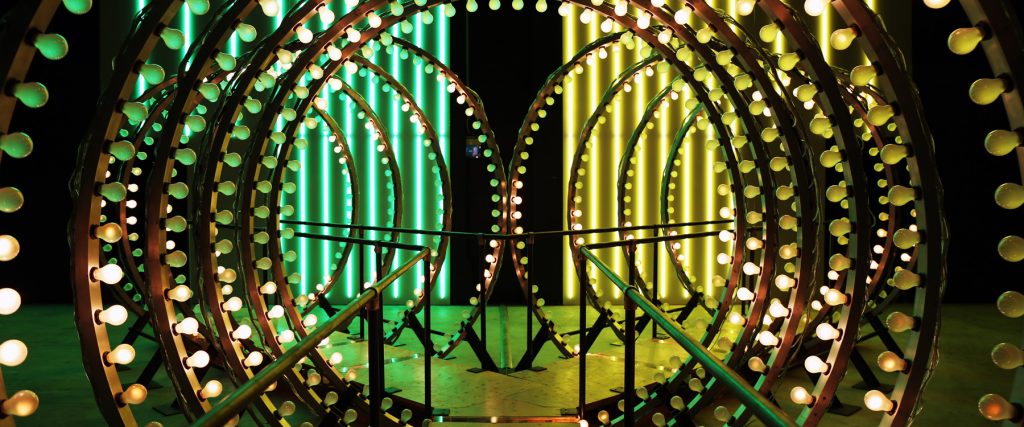
[video src=https://vimeo.com/161752738]In Doubt, artist Carsten Höller challenges our perceptions of reality through coded sequences of light and spatio-temporal illusions. His goal was to blur the lines between spectator and performer within a work of art, while instilling a deep feeling of doubt inside us. The installation begins as a single hallway of light, which subsequently divides itself into two paths, each of which is individually illuminated by either yellow or green lights. Once a spectator chooses a path, they are presented with a multi-level maze of sorts, which combines different sequences of light projection with moments of darkness to challenge our perceptual framework.
Likeness
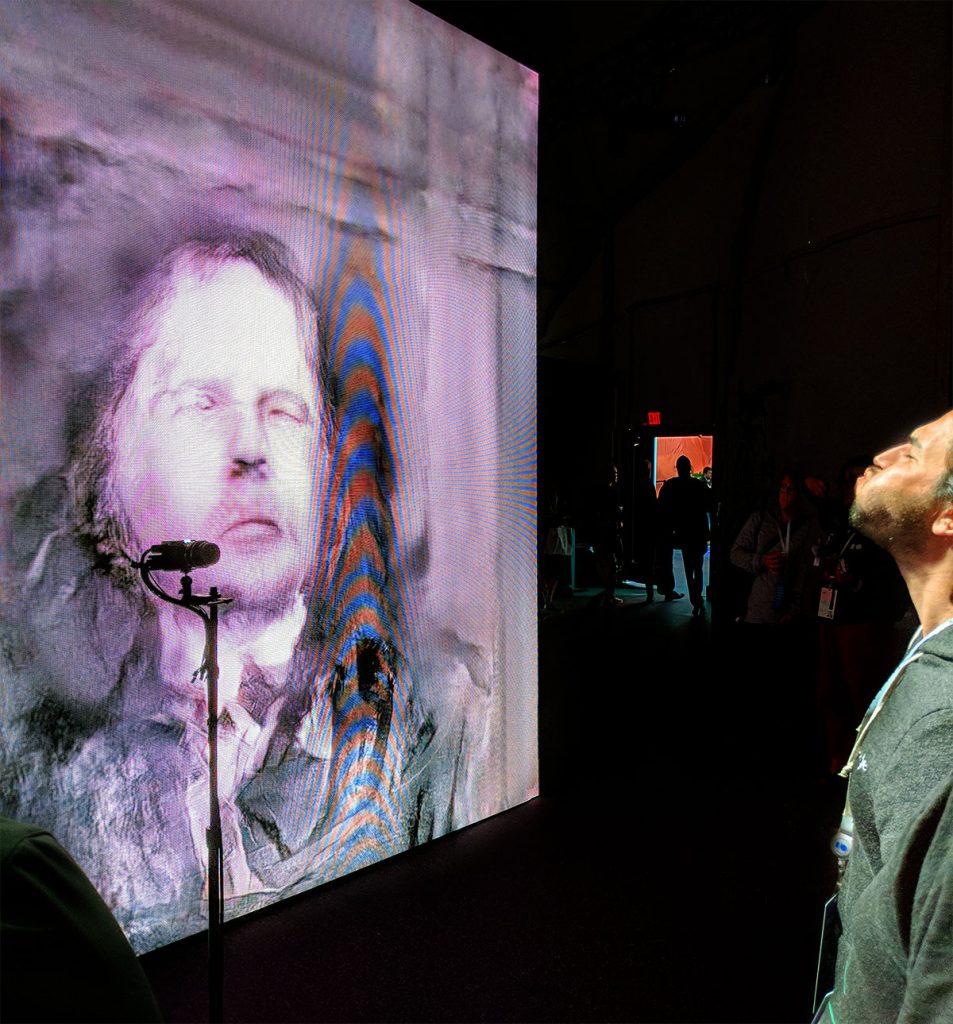
[video src=https://www.youtube.com/watch?time_continue=99&v=wVYJ8EwL7WA height:195 align:right] Adam Ferriss’s art installation from June 2018, Likeness, takes one person’s face and transforms it into another. It “reimagines face-filtering and remolds people’s appearances in real time.” Likeness, curated by Alex Czetwertynski, another digital artist and curator, was produced for Google IO 2018 in the Museum of Developer Art and commissioned by UCLA Conditional Studio. Ferriss began his installation by presenting the computer two sets of images: generic photographs of people, and what Ferriss calls “label maps” that “identify and highlight the different facial features, like eyes, eyebrows, jawline, mouth, and nose, present in the photographs."
All Things Fall

[video src=https://vimeo.com/125791075 height:200 align: right ]All Things Fall by Mat Collishaw and Sebastian Burton was first presented in 2014 during a solo exhibition titled “Black Mirror” at Galleria Borghese held in Rome [3]. The piece is powered by an electric motor and lit by numerous led lights placed all around the figurines which flash in repetition creating the illusion of motion. The zoetrope was originally designed in three dimensions. Each model figure was 3D printed at Sicnova 3D, a Spanish company specializing in 3D printing. The material used is not your average plastic found in most conventional 3D printers. Each of the figures are made from an ABS (Acrylonitrile Butadiene Styrene) material, which is a specialized hard plastic used for the prototype printer that created all of the individual components of the piece.
Migration (Empire) by Doug Aitken

[video src=[video src=https://www.youtube.com/watch?v=JZ6cJaGm79E]]American hotel rooms are where Doug Aitken’s short film Migration (Empire) takes place. The artist unexpectedly mixed the scenes of motel room settings with wild animals. As the animal explore the ubiquitous industrial interiors, the film explores the relationship between these American untamed wilderness and our human involvement of industrialization. The film includes many beautiful but also cruel scenes, such as a fox wandering in the motel room and noticing the view outside of the window is different because of the mesh screen; a deer drinking water from a swimming pool; an otter bathing in a bath tub. The film shifts continuously shifts to another animal, another occupant with a new room, suggesting the homelessness embodied by the motel room.
Route One

[video src=https://www.youtube.com/watch?v=G54tllj-SKI&t=6946s] Icelandic avant-rock band, Sigur Rós created Route One in 2016. This 24 hour long, TV production was intended to be broadcast live on BBC4 as well as Youtube.com. The band created this television event to accompany the release of their then newly released single, ‘óveður’. In this live-streamed youtube production, the band travels on the longest day of summer in Iceland, traversing Route One, a road spanning around the entirety of Iceland’s 1332km Ring Road.
Polarseeds

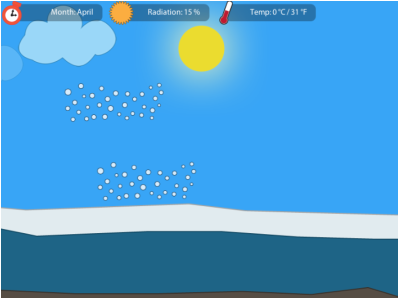 THE POLARSEEDS PROJECT: COMMUNICATING GREENLAND MELTING THROUGH VISUALIZATION AND SONIFICATION. Marco Tedesco, associate professor of earth and atmospheric sciences at the City College of New York, noted the beauty of climate science, such as flooding, cloud structure, and melting ice. To make climate science more attractive, he and his colleagues have jointly developed a research project called "Polarseeds" to present the diverse art of climate science through visual arts, music, and games.
THE POLARSEEDS PROJECT: COMMUNICATING GREENLAND MELTING THROUGH VISUALIZATION AND SONIFICATION. Marco Tedesco, associate professor of earth and atmospheric sciences at the City College of New York, noted the beauty of climate science, such as flooding, cloud structure, and melting ice. To make climate science more attractive, he and his colleagues have jointly developed a research project called "Polarseeds" to present the diverse art of climate science through visual arts, music, and games.
Deep Sleep Trawler

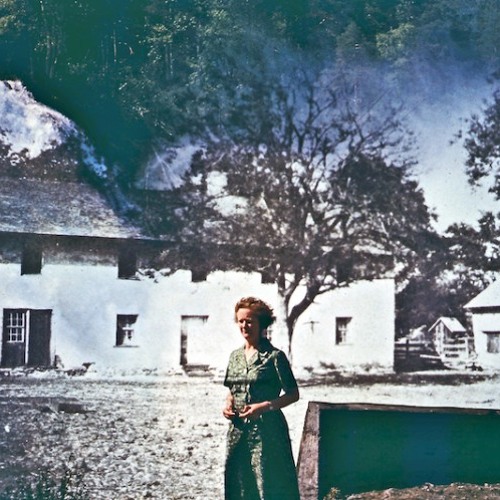 As the digital artist in residence at Forth Valley Royal Hospital in Scotland, sound artist Mark Vernon created a series of four sound art pieces, called "Bedside Radio," designed to be played over the hospital's radio station, Radio Royal. The third of these pieces, Deep Sleep Trawler, was created in 2012 "with the intention of creating a database or 'dream bank' to provide sleep deprived hospital patients with the opportunity of sharing someone else's dreams."
As the digital artist in residence at Forth Valley Royal Hospital in Scotland, sound artist Mark Vernon created a series of four sound art pieces, called "Bedside Radio," designed to be played over the hospital's radio station, Radio Royal. The third of these pieces, Deep Sleep Trawler, was created in 2012 "with the intention of creating a database or 'dream bank' to provide sleep deprived hospital patients with the opportunity of sharing someone else's dreams."
Force of Nature
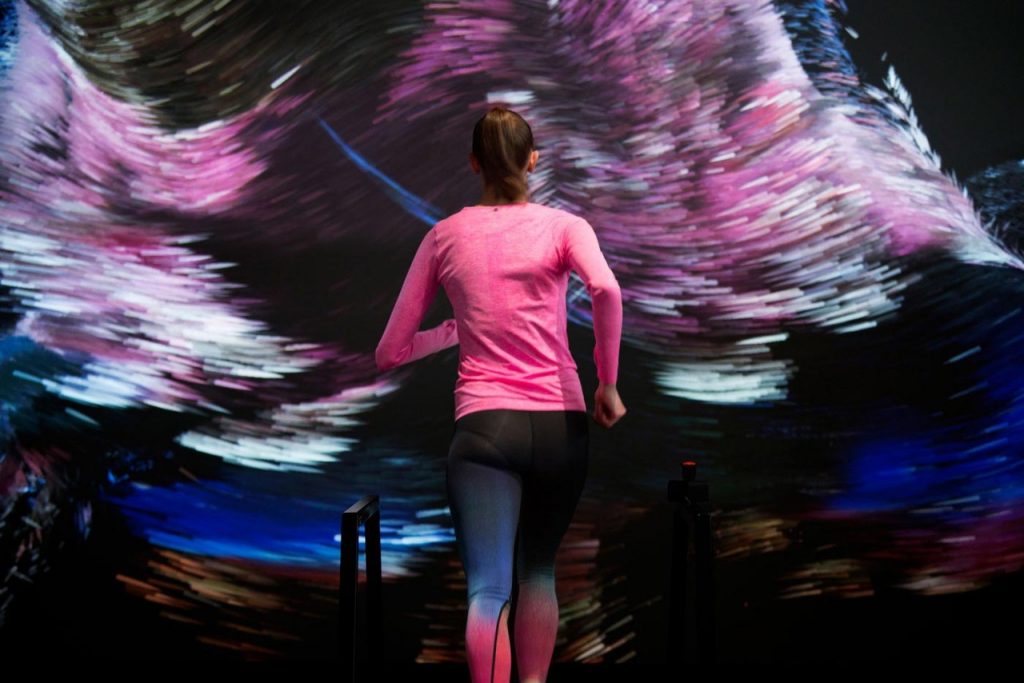
 In April 2015, Nike released its revolutionary kinetic digital art project, Force of Nature, for the Nike Innovation Summit at Truman Brewery in London. The work was created in collaboration with Field, a London-based design studio. By stepping onto a treadmill and beginning to create movement, the participating runner is presented with a fluctuating shower of stunning, multicolored sparks, similar to an energy “mirror” of themselves, created by the movement put forth by him or her on the treadmill. The flux of lights is meant to imitate the runner’s motion and turn the human body into a digital art piece. [1]. The work recalls earlier artworks, including Nancy Paterson's Bicycle TV (1989) and Jeffery Shaw's Legible City (1989-91), both of which used a bicycle as the interface by which the user's activity generates an animated video environment.
In April 2015, Nike released its revolutionary kinetic digital art project, Force of Nature, for the Nike Innovation Summit at Truman Brewery in London. The work was created in collaboration with Field, a London-based design studio. By stepping onto a treadmill and beginning to create movement, the participating runner is presented with a fluctuating shower of stunning, multicolored sparks, similar to an energy “mirror” of themselves, created by the movement put forth by him or her on the treadmill. The flux of lights is meant to imitate the runner’s motion and turn the human body into a digital art piece. [1]. The work recalls earlier artworks, including Nancy Paterson's Bicycle TV (1989) and Jeffery Shaw's Legible City (1989-91), both of which used a bicycle as the interface by which the user's activity generates an animated video environment.
Song of the Phenomena
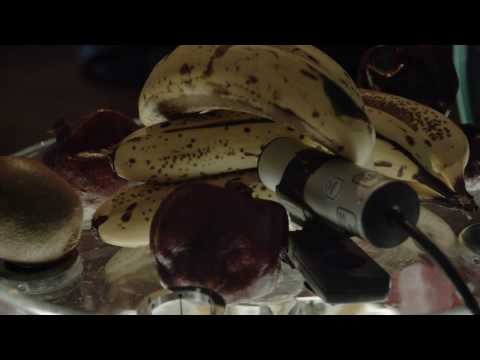
[video src=https://youtu.be/pcvVotT2XQo] Chris Henschke is an Australian digital artist who studies scientific concepts like physics, sound and light, and other phenomena. He and Mark Boland, an Australian Synchrotron physicist, collaborated on an exhibit called "Song of the Phenomena", which was displayed in the Royal Melbourne Institute of Technology Gallery in 2016. "Song of the Phenomena" includes a machine that is activated by the atomic radiating particles emitting from decomposing fruit and converted into sound. The machine was once used to calibrate radiation oncology treatments.
CAPSID

[video src=https://www.youtube.com/watch?v=l8IhFWiri5o]London-based artist John Walter spent three years studying with Greg Towers at UCL to better understand the interactions between a virus and its host, specifically HIV-1 and the effect of AIDS on the human body's immune system. His meticulous research is shown in his new multimedia project CAPSID, featuring a short film titled A Virus Walks Into a Bar, which pulls the "bar" motif of British soap operas to present an analogous tale of how HIV enters human cells and destroys them from within. Through this film – as well as paintings and installations – Walter's work not only uncovers new ways of expressing how HIV behaves, but presents his findings in a way that the non-scientifically-inclined can understand.
Digital Instru-Mentation: Red Forest and Emblems of Ascension

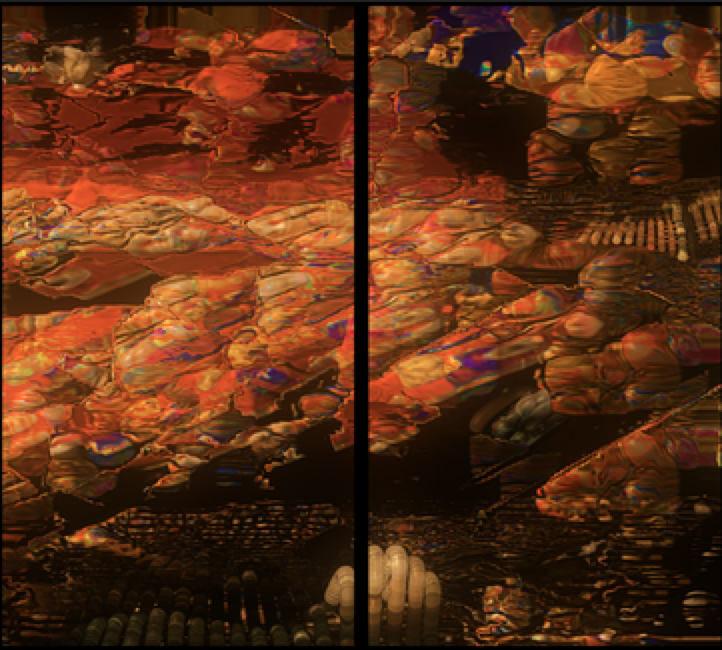 Digital art, as in the work of Robert Campbell (Red Forest, detail) and NoiseFold is achieving the plasticity of clay, paint on canvas, or even analog electronics. Several Currents 2015 participants have developed, or cobbled together, computer based tools which provide the robustness needed to dig in, explore, and experiment with contemporary new media materials and techniques. It's much like the shift from the brush of a Mannerist painter to the sponge of a Max Ernst frottage.Progress in the flexibility and robustness of digital instruments allow them to be treated as plastic media which may lead to fully collaborative human/machine systems. We can start to imagine an actual collaboration between humans and machines where, rather than participating in a one-way struggle, each contribute what they do best in a two-way dialog. And once these collaborative systems are established, their collective behavior will become more interesting than any particular 'finished work'.
Digital art, as in the work of Robert Campbell (Red Forest, detail) and NoiseFold is achieving the plasticity of clay, paint on canvas, or even analog electronics. Several Currents 2015 participants have developed, or cobbled together, computer based tools which provide the robustness needed to dig in, explore, and experiment with contemporary new media materials and techniques. It's much like the shift from the brush of a Mannerist painter to the sponge of a Max Ernst frottage.Progress in the flexibility and robustness of digital instruments allow them to be treated as plastic media which may lead to fully collaborative human/machine systems. We can start to imagine an actual collaboration between humans and machines where, rather than participating in a one-way struggle, each contribute what they do best in a two-way dialog. And once these collaborative systems are established, their collective behavior will become more interesting than any particular 'finished work'.
The Island of Pal
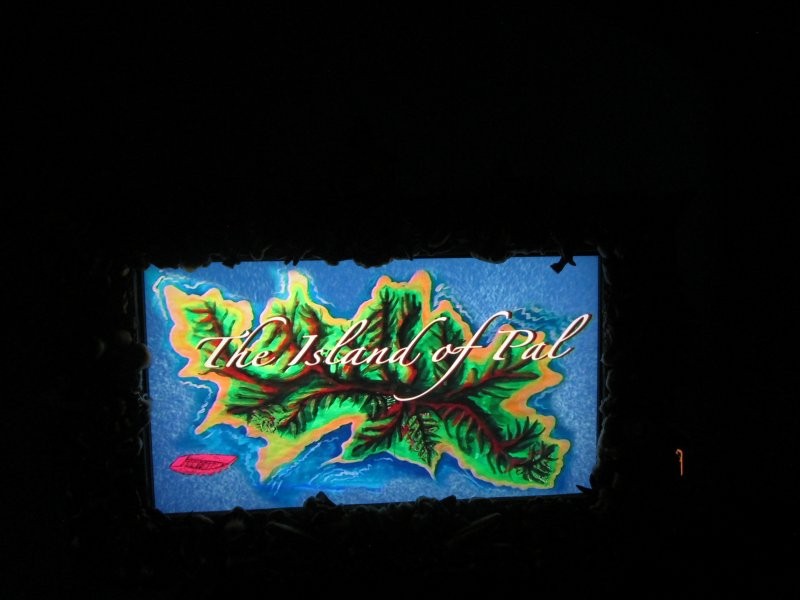
 Little red skiffs float on undulating waters along with armchairs, fully made beds, and spiraling severed horses' heads in the throbbing air. Three toy horses are posed on synthetic turf in a theatrically raked trapezoidal corral bordered by tiny rope footlights. No bridles or saddles are ever in view; these are wild horses temporarily and ever-so-lightly penned in by a white picket fence. Enclosed inside the skewed geometry and oblique angles the equine visitors—a palomino named Pal, a buckskin called Bonnie, and her sometimes partner, the black-coated Clyde—are here to entice playmates. Inside a bricolage gilt frame a ten-minute video containing all of these disparate constituents (and new characters too) offers a dream narrative of these fantastical beings, delighting in an idyll of grasslands and wildflowers.
Little red skiffs float on undulating waters along with armchairs, fully made beds, and spiraling severed horses' heads in the throbbing air. Three toy horses are posed on synthetic turf in a theatrically raked trapezoidal corral bordered by tiny rope footlights. No bridles or saddles are ever in view; these are wild horses temporarily and ever-so-lightly penned in by a white picket fence. Enclosed inside the skewed geometry and oblique angles the equine visitors—a palomino named Pal, a buckskin called Bonnie, and her sometimes partner, the black-coated Clyde—are here to entice playmates. Inside a bricolage gilt frame a ten-minute video containing all of these disparate constituents (and new characters too) offers a dream narrative of these fantastical beings, delighting in an idyll of grasslands and wildflowers.
Two Women
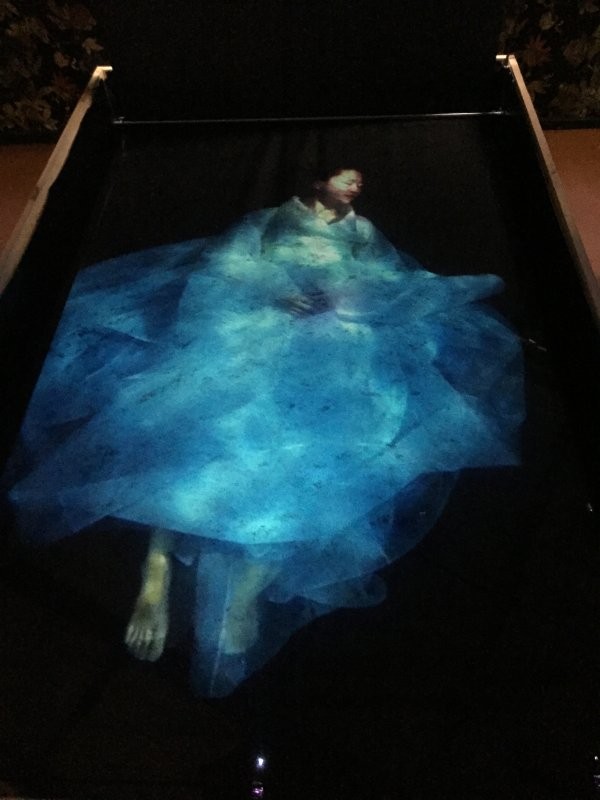
 Two women: one is young, angelic, billowing and dream like; the other alternates between the fetal position and the floating corpse pose. Side by side, the wood framed vessels into which the the images are projected and submerged in water, read as both boat and coffin. Like flowers dropped from the installation’s peeling wallpaper or the Chinese screens described by the narrator as she recounts a dream that turns into a nightmare, the water is the source of life of death. In Two Women, the gasping for air is visceral as the older woman contorts her body and I, the witness, listen to her story in Korean, read it in English and hear the stylus punctuate it into fabric as Morse code, the universal language associated with distress.
Two women: one is young, angelic, billowing and dream like; the other alternates between the fetal position and the floating corpse pose. Side by side, the wood framed vessels into which the the images are projected and submerged in water, read as both boat and coffin. Like flowers dropped from the installation’s peeling wallpaper or the Chinese screens described by the narrator as she recounts a dream that turns into a nightmare, the water is the source of life of death. In Two Women, the gasping for air is visceral as the older woman contorts her body and I, the witness, listen to her story in Korean, read it in English and hear the stylus punctuate it into fabric as Morse code, the universal language associated with distress.
Threads

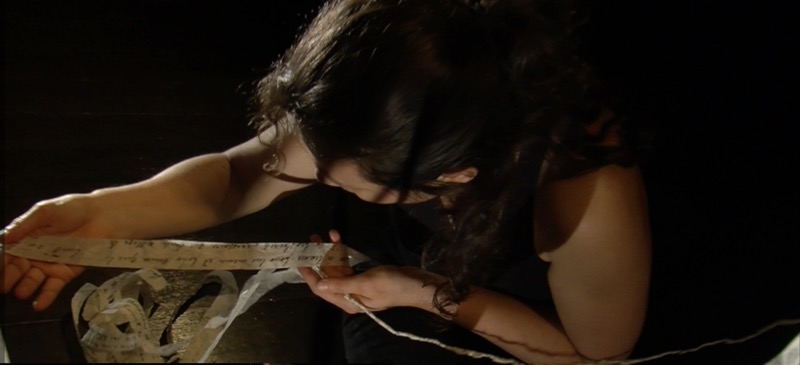 There is something in the wind that is mystical: how it sounds, how it moves things. The ethereal, this effect that leads you to memories because deep inside you want things to last, we cling to what we call the root of our existence and we want to pass this on.
There is something in the wind that is mystical: how it sounds, how it moves things. The ethereal, this effect that leads you to memories because deep inside you want things to last, we cling to what we call the root of our existence and we want to pass this on.
But just as the wind, we do our reinterpretations of phenomena, and disappear. We are forever stuck in the cycle of our perception weaving our past and colliding with our present.
Mypocket
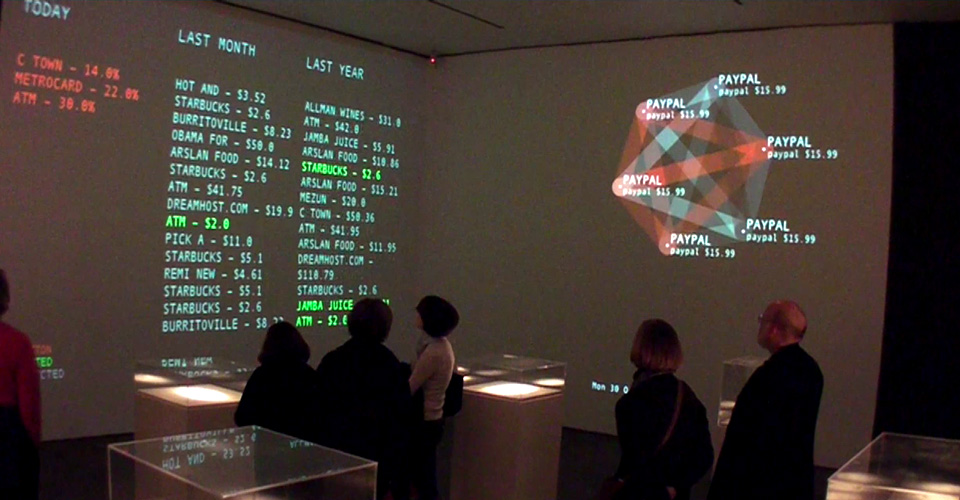
 MYPOCKET by Burak Arikan traces simultaneously a personal history of expenditures and universal financial forecast. The artist has meticulously retained physical and virtual evidence of all his expenditures, creating a database visualization of their passage and custom software algorithm of their probability of recurrence. The Transactions Feed archives all of his economic interactions (thereby making all his personal financial records public), and posts their percentaged predictions.
MYPOCKET by Burak Arikan traces simultaneously a personal history of expenditures and universal financial forecast. The artist has meticulously retained physical and virtual evidence of all his expenditures, creating a database visualization of their passage and custom software algorithm of their probability of recurrence. The Transactions Feed archives all of his economic interactions (thereby making all his personal financial records public), and posts their percentaged predictions.
Wave UFO
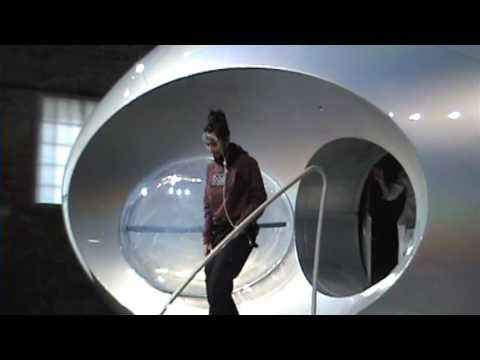
[video src= https://www.youtube.com/watch?v=Q8QbcyKwWNo align: left height: 200] Combining her love of sci-fi and her penchant for installations, artist Mariko Mori created a unique, encapsulating experience that literally transports the viewers to another world in Wave UFO. Mariko's goal is to make the audience experience what it would be like to go to another planet. Inside of the pod, visitors are given "a set of electrodes that gather brainwave data" [1] that feed to a video monitor inside of the pod. This is played alongside a second video screen, and those two coupled together represent both sides of the brain's psychology and functions. Viewers recline in padded seats placed around the pod, in which they watch the two screens. After the seven minutes of footage end, visitors disembark via the staircase.
Live-Taped Video Corridor
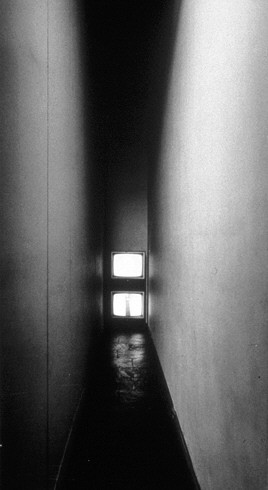
[1] Beginning in the early 20th century, artists and philosophers began to challenge the well-defined line that had been previously drawn between an artist and their audience. These thinkers included creatives such as Marcel Duchamp, who expressed his belief that in art, the work is not whole without active participation from the spectator, that “the […]
The Event of a Thread

Ann Hamilton's 2012 piece, "The Event of a Thread," was a massive art installation that spans the entirety of the Park Avenue Armory in New York City. The work was meant to respond and interact with the space's architecture and internal structures, as well as to be interactive with the audience. The space was divided, […]
Thunder

[video src=https://vimeo.com/12024934 height:220 align:left hspace:10]The Japanese experimental visual artist Takashi Ito’s 1982 short film Thunder tests two extremes of the fairly conventional medium of film. A five minute pulsing odyssey through an industrial architectural network, fueled by long exposure light drawings and a mechanical score that perverts both voice and glass samples, Thunder is maximal in its approach to providing audiovisual information, while boldly displaying a lack of kinetic cohesion. The entirety of the film consists of sequenced photographs, relying on the phenomenon of persistence of vision to enable the viewer to “perceive motion smoothly unfold over time.”
Inorganic Flora

Combining the delicate, intricate folds of nature with the hard, clinical use of computer algorithms, artist Macoto Murayama digitally sculpts flowers that he painstakingly dismantles in order to further understand their structures. Working mostly in Japan, Murayama is a botanist, as well as an artist, who attended Miyagi University in 2007, and went […]
MILKProject

Esther Polak and Ivar van Bekkum’s MILKproject, produced in 2003 and 2004, is a prime example of locative art; works that utilize location-based media such as GPS or Google Earth in order to explore spatial interaction, or in the case of Polak and van Bekkum’s work in question, human reaction to digitally tracked patterns. The […]
Nocturnal Flow

 Erwin Redl’s large-scale light installation Nocturnal Flow presents itself as a sea of LEDs stretching from floor to ceiling of the University of Washington’s Allen Center. Composed of over 10,000 individual light units whose intensity varies through time, the grid-like work serves both to emphasize the verticality of the space in which it is housed, but also to accommodate a natural motion birthed from sterility. The use of environmentally-reponsive sensors also imbues the work with a streak of subjectivity, as it can be perceived in contrasting ways depending not only on angle of view, but also time of day or year.
Erwin Redl’s large-scale light installation Nocturnal Flow presents itself as a sea of LEDs stretching from floor to ceiling of the University of Washington’s Allen Center. Composed of over 10,000 individual light units whose intensity varies through time, the grid-like work serves both to emphasize the verticality of the space in which it is housed, but also to accommodate a natural motion birthed from sterility. The use of environmentally-reponsive sensors also imbues the work with a streak of subjectivity, as it can be perceived in contrasting ways depending not only on angle of view, but also time of day or year.
The Tunnel under the Atlantic
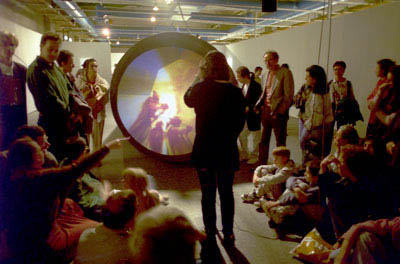
[video src=http://youtu.be/gQ2Ti6nB9mg align: right height: 220] The Tunnel under the Atlantic, by Maurice Benayoun is an interesting stimulatory system that connects visitors of the Pompidou Centre in Paris to the visitors of the Museum of Contemporary Art in Montreal through a simulated “digging” through skewed virtual medium. By using televirtuality, people in each museum can dig to meet each other, and then interact with each other in this virtual channel. They are brought together through communication as they survey their virtual surroundings that reveal geological strata as iconographic strata, bringing both shape and recognizable textures.
The Yes Men

[video src=http://www.youtube.com/watch?v=LiWlvBro9eI align: left height: 200] There are innumerable strategies and motivations behind impersonation on the Internet. Some are legitimate hoaxes, others malicious, others satire. Take this typo for example: Gogle.com. Hypothetically, for every person with a sticky "o" key, or too fast of a double-keystroke, there is someone out there who is able to maliciously attack the unfortunately imperfect typist, logging history, Internet etiquette, and personal data. Inversely, one could hypothetically use similar guerilla tactics to attack companies of questionable moral standing, which is exactly what an internet-hoax group, referred to as “The Yes Men,” have done.
Point Cloud

[video src=http://vimeo.com/42896836 align: right height: 220] James Leng’s Point Cloud redefines art by introducing weather as a form of artistic expression. The work’s sculptural form is “defined by a thin wire mesh, driven asynchronously by 8 individual servos controlled via Arduino. As whiteness of the hanging structure begins to disappear into the background, the viewer is treated to a constantly morphing swarm of black points dancing through midair.” Digital data is “transformed into a natural pattern of movement… ” The Point Cloud simulates changes in “stability and turbulence, expansion and contraction . . .[it] “creates a visceral experience in our interactions with weather.”
Natural History of the Enigma

 “Natural History of the Enigma” is a series of works that presents the transgenic petunia flower “Edunia”, which has part of the artist Eduardo Kac’s genetic sequence inserted into it. Aside from the plant itself, the series comprises of limited edition seed packs of the plant, a set of lithographs called “Edunia Seed Pack Studies”, the public sculpture “Singularis”, watercolor paintings “Mysterium Magnum I-VIII”, and photographs of the plant “Plantimal I-VI”. The project was developed by Eduardo Kac in collaboration with scientists from University of Minnesota between 2003 and 2008, and was initially exhibited at the Weisman Art Museum in Minneapolis [1].
“Natural History of the Enigma” is a series of works that presents the transgenic petunia flower “Edunia”, which has part of the artist Eduardo Kac’s genetic sequence inserted into it. Aside from the plant itself, the series comprises of limited edition seed packs of the plant, a set of lithographs called “Edunia Seed Pack Studies”, the public sculpture “Singularis”, watercolor paintings “Mysterium Magnum I-VIII”, and photographs of the plant “Plantimal I-VI”. The project was developed by Eduardo Kac in collaboration with scientists from University of Minnesota between 2003 and 2008, and was initially exhibited at the Weisman Art Museum in Minneapolis [1].
The Painting Fool

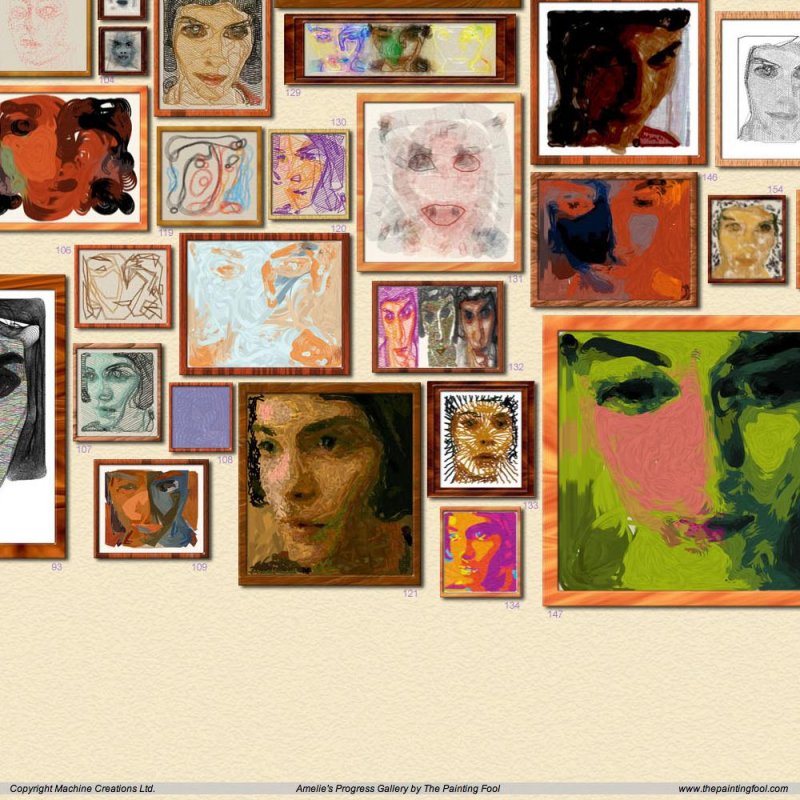 The Painting Fool is a computer program and artwork developed originally in 2001 by Simon Colton and researchers at the Computational Creativity Research Group at Imperial College, London. Colton’s ultimate goal for The Painting Fool was to create a piece that is seen as purely creative, what he refers to as “Computational Creativity”; he believed that to achieve this The Painting Fool was required to have behaviors that are skillful, appreciative, and imaginative. Skillful behaviors deal with the mechanical physical process of painting. The Painting Fool is able to take a scan of a photograph and determine the individual colors used within the composition, grouping them together in similar palettes. In addition The Painting Fool records the different pastel, pencil, and brush strokes as well as an analysis of the animation of strokes
The Painting Fool is a computer program and artwork developed originally in 2001 by Simon Colton and researchers at the Computational Creativity Research Group at Imperial College, London. Colton’s ultimate goal for The Painting Fool was to create a piece that is seen as purely creative, what he refers to as “Computational Creativity”; he believed that to achieve this The Painting Fool was required to have behaviors that are skillful, appreciative, and imaginative. Skillful behaviors deal with the mechanical physical process of painting. The Painting Fool is able to take a scan of a photograph and determine the individual colors used within the composition, grouping them together in similar palettes. In addition The Painting Fool records the different pastel, pencil, and brush strokes as well as an analysis of the animation of strokes
A Sound Garden

[video src=https://www.youtube.com/watch?v=1aGUPZc53cQ height: 180 align: right] A Sound Garden, by Douglas Hollis, is an "aeolean" sound sculpture comprised of 12 tower-like structures. An aeolean instrument is one that wind-driven, a reference to Aeolus, the Greek god of wind. The structures contain pipes that generate a wide variety of sounds, depending on wind speed and direction [2]. As this area is subject to frequent winds of varying intensity, A Sound Garden the visitor will almost always hear it in action and may be treated to a dynamic wind-driven concert as the sounds respond to changes in the winds. A Sound Garden is also notable as the inspiration for the eponymous Seattle grunge band, Soundgarden.
Sound Bites City

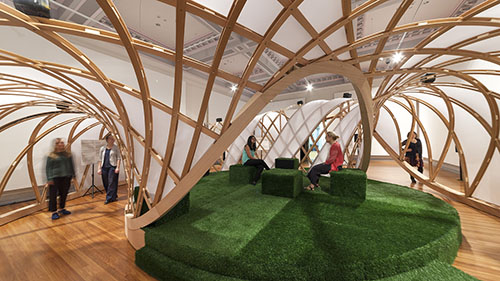 Sound Bites City is a collection of sound art from 19 sound artists from around the world at the RMIT University in Australia. Exhibited at the RMIT University Gallery, the sound art is played through speakers that are scattered around a round physical structure that culminates with a raised, faux, grassy knoll. This space is called the Torus. RMIT University describes the Torus as “an exciting circular structure that has been specially designed by architects, engineers and sound designers based in RMIT’s SIAL unit to provide the best way to exhibit sound.”
Sound Bites City is a collection of sound art from 19 sound artists from around the world at the RMIT University in Australia. Exhibited at the RMIT University Gallery, the sound art is played through speakers that are scattered around a round physical structure that culminates with a raised, faux, grassy knoll. This space is called the Torus. RMIT University describes the Torus as “an exciting circular structure that has been specially designed by architects, engineers and sound designers based in RMIT’s SIAL unit to provide the best way to exhibit sound.”
Net Blow-Up

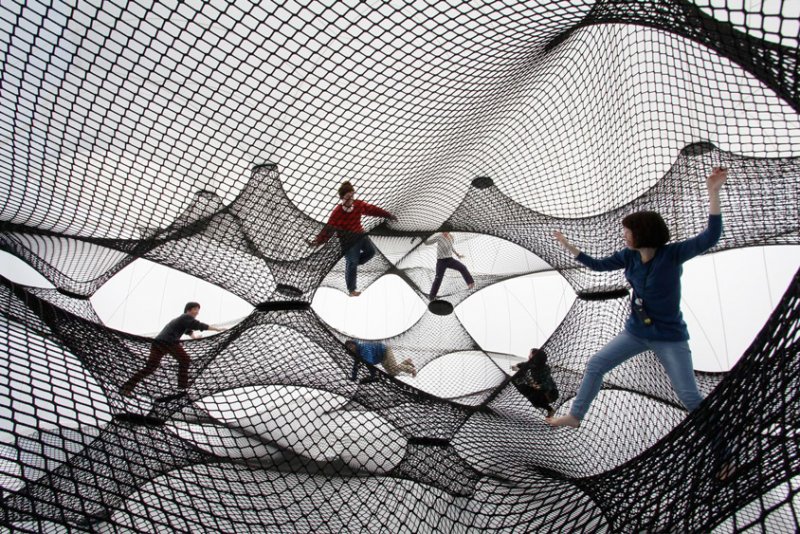 The Net Blow-Up exhibit, by croatian-austrian design collective Numen/For Use, is a highly interactive sculpture evoking nostalgia from the bouncy-castles of our youth. “Although the history of art has cultishly celebrated the individual genius, the field increasingly has recognized the importance of exhibitions, institutions and communities in shaping the production, reception and historical contextualization of art.” [1] This collaborative effort is humble, playful and simple in a way that is a necessary counterpoint to the pretentiousness that feeds the majority of modern art. I do not intend to belittle the cutting edge; I just mean that without exhibits like Net Blow-Up the world of art would be a lot less fun.
The Net Blow-Up exhibit, by croatian-austrian design collective Numen/For Use, is a highly interactive sculpture evoking nostalgia from the bouncy-castles of our youth. “Although the history of art has cultishly celebrated the individual genius, the field increasingly has recognized the importance of exhibitions, institutions and communities in shaping the production, reception and historical contextualization of art.” [1] This collaborative effort is humble, playful and simple in a way that is a necessary counterpoint to the pretentiousness that feeds the majority of modern art. I do not intend to belittle the cutting edge; I just mean that without exhibits like Net Blow-Up the world of art would be a lot less fun.
Ominous


“Ominous” is an audio-visual performance by Marco Donnarumma in which the artist uses his body to compose sound pieces using a device that records his movements. The piece was commissioned by the European Conference of Promoters of New Music (ECPNM) for the occasion of the 5th Live Electronic Music Project Competition. It premiered on 3rd November 2012 at the World’s New Music Days, and since then has been performed at various other venues such as National Academy of Arts in Bulgaria, New York Electronic Arts Festival, etc [1].
Mechanical Parts

[video src=http://vimeo.com/78771257 align: right height: 220] Mechanical Parts is a series of illustrations drawn by a robot programmed by artist Matthias Dörfelt. His machine, named ‘Robo Fabers,’ rolls across the paper and creates drawings autonomously, while adhering to a set of… interesting guidelines Dörfelt programmed it with. As he told Gizmodo, “basically [Robo Fabers] is doodling connectors—think of it as robot genitalia—as a first step of planing reproduction.” The machine randomly arranges various permutations of components as specified by Dörfelt. Most noticeably, shapes clearly resembling hairy and shorn testicles, phalluses, sperm, holes, and eggs are are visible in the drawings pictured above.
Times Square
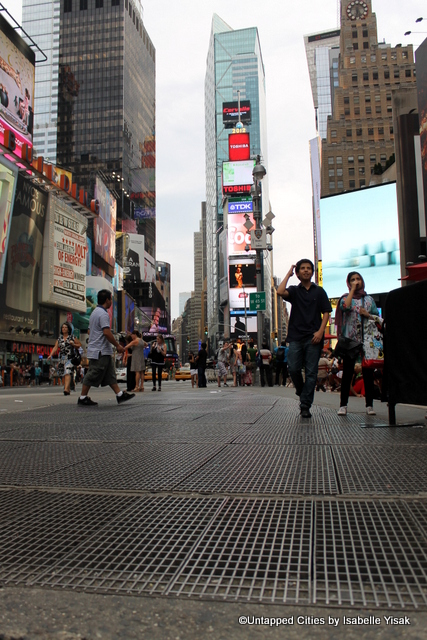
Amidst the busy crowds and bustling traffic, people walking in New York Times Square can easily become lost in the various sounds. But if someone truly and intently listens, he or she can hear the unique art of sound sculptor Max Neuhaus, who specializes in sound technology works, including "Sound Figure" that he made in […]
A Bell for Every Minute

[video src=http://www.youtube.com/watch?v=8nymgN5MuDI align: right height: 220] A Bell for Every Minute is a sound installation by artist Stephen Vitiello, located on the High Line in New York City. Vitiello recorded 59 bells from all over New York City. These include landmark bells such New York Stock Exchange bell, the Dreamland Bell, the United Nation’s Peace Bell, and more common, everyday bells such as bike bells, diner bells, and church bells. Vitiello placed speakers throughout the 14th Street Passage, a tunnel between West 13th and West 14th Streets. Each minute, a bell rings from the speakers. At the top of each hour, all of the different bells ring at once in a chorus that fills the space.
Rain Room

[video src= http://www.youtube.com/watch?v=EkvazIZx-F0 align:right height:220] Rain Room is an interactive installation piece created by rAndom International, a multimedia artistic team based in London. This artwork seeks to emulate the experience of rain in an indoor setting; within a large room, drops of water fall from the ceiling, creating a constant, thunderous downpour. When a person is introduced to this space, they are monitored by 3D depth cameras that inform Rain Room’s software system of the person’s exact location, causing the rain directly above the individual to cease. As a result of this technology, a person remains dry as they move throughout the space.
All My Life For Sale

All My Life For Sale is a work by John Freyer where he sells everything he owns online. When I say everything I mean everything, Freyer finished by selling the domain name itself. This work of art is part of a collection on Rhizome entitled Digital Archivalism. This form of art blends anthropology and […]
Hello World! Or: How I Learned to Stop Listening and Love the Noise

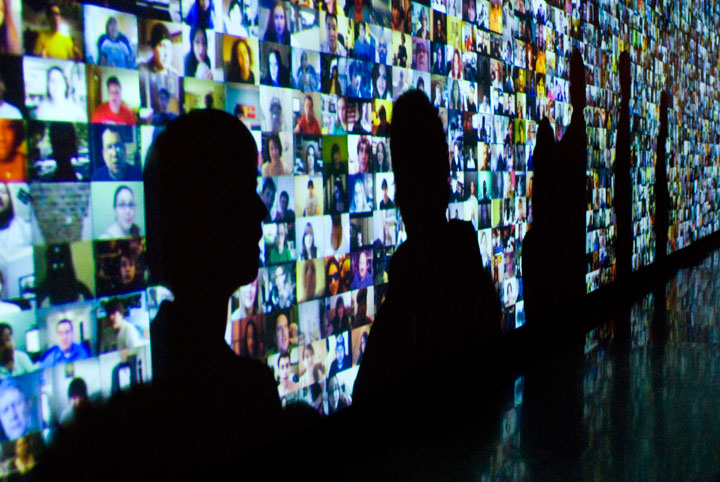 Hello World! is a large-scale audio visual installation comprised of thousands of unique video diaries gathered from the internet. The project is a meditation on the contemporary plight of democratic, participative media and the fundamental human desire to be heard. Hello World is the first program that is traditionally taught in any programming language, and How I Learned to Stop Listening and Love the Noise references the Stanley Kubrick film Dr. Strangelove. The installation tries to capture the vast archive of one-person narratives that exist on the Internet and emphasize them as a collective whole rather than as individuals.
Hello World! is a large-scale audio visual installation comprised of thousands of unique video diaries gathered from the internet. The project is a meditation on the contemporary plight of democratic, participative media and the fundamental human desire to be heard. Hello World is the first program that is traditionally taught in any programming language, and How I Learned to Stop Listening and Love the Noise references the Stanley Kubrick film Dr. Strangelove. The installation tries to capture the vast archive of one-person narratives that exist on the Internet and emphasize them as a collective whole rather than as individuals.
Cory’s Yellow Chair

Cory’s Yellow Chair is a kinetic sculpture by Arthur Ganson that assembles, disassembles, and reconstructs a small, four-and-a-half-inch tall yellow chair indefinitely. Ganson says he got inspiration for this piece when his “son’s little yellow chair explode with infinite speed, travel to the far reaches of the universe and slowly come to complete stillness. Then, […]
Sonic Water

 “Sonic Water,” by artists Sven Meyer and Kim Pörksen, is an interactive cymatic installation that explores the visualization of sound though water. The audience can walk up to a container of water, which is set atop speakers, and introduce their own input sound: voice, a song recording, or another sound source. The result of these sound vibrations is unique patterns in the water that are photographed from above. This exhibit is an interesting example of how feedback can create and alter a physical medium to visualize something so invisible as sound.
“Sonic Water,” by artists Sven Meyer and Kim Pörksen, is an interactive cymatic installation that explores the visualization of sound though water. The audience can walk up to a container of water, which is set atop speakers, and introduce their own input sound: voice, a song recording, or another sound source. The result of these sound vibrations is unique patterns in the water that are photographed from above. This exhibit is an interesting example of how feedback can create and alter a physical medium to visualize something so invisible as sound.
Machine with Concrete

Arthur Ganson's Machine with Concrete stands out because it breaks the unwritten creed of machines. Almost all machines we build are created to make things go faster. In factories, machines build products with precision much faster than human workers could. In our pockets, our cell phones convey messages from person to person over vast distances in […]
